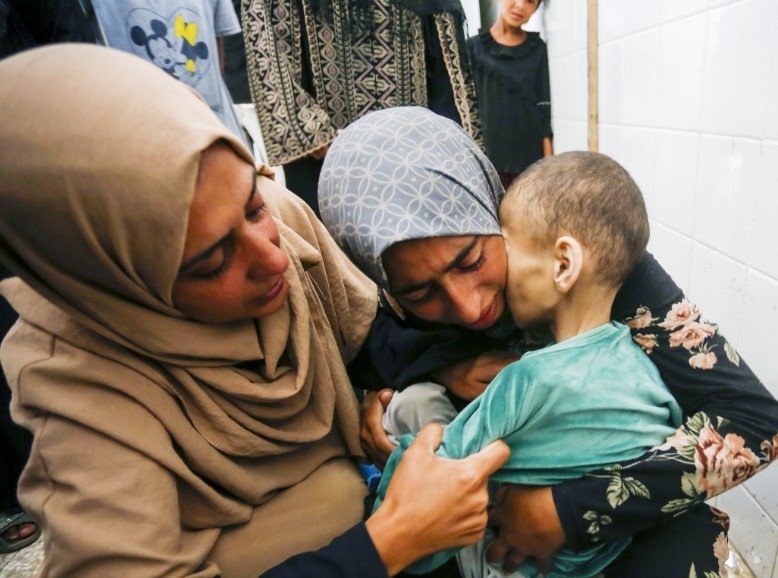Israeli gunfire at aid points claims scores of lives amid deepening starvation; survivors speak of despair and collapse
As the sun rose over the scorched ruins of Gaza on Sunday, chaos unfolded near aid points where hungry families had gathered with one faint hope: food. By nightfall, that hope had turned to horror.
Israeli forces killed at least 115 Palestinians, according to Gaza’s health authorities, including 79 people shot near the Zikim crossing in the north as they scrambled for flour. Nineteen others died of starvation in the past 24 hours, as a siege that began months ago has now turned Gaza’s humanitarian crisis into a full-blown famine.
Health workers and survivors described a day of carnage and collapse. In Rafah and Khan Younis in southern Gaza, 13 more were killed while seeking aid.
No ambulances arrived for the dying. No food arrived for the hungry.

‘We were the ambulance’: A survivor’s agony
At the Zikim crossing, Rizeq Betaar, a father of four, said he watched a boy collapse from gunfire, limp and bleeding in the dirt. No help came. So he and another man did what they could — they placed him on a bicycle and pedaled frantically toward a medical outpost.
“There is nothing,” Betaar said. “No ambulances, no food, no life, no way to live any more. We’re barely hanging on.”
Photos later showed dozens of bodies lying face down in the sand, many wearing the dust-covered remnants of what had once been school uniforms, work jackets, and prayer garb.
Shootings amid starvation
According to the Palestinian Civil Defence, Israeli forces opened fire near at least three aid distribution zones on Sunday:
-
Zikim, where at least 79 people were shot dead, many while queuing for UN flour deliveries
-
Rafah, where nine more were killed near a UNRWA tent encampment
-
Khan Younis, where another four were confirmed dead
The shootings unfolded in areas that had seen thousands of civilians converge after rumors spread of limited aid shipments arriving under Israeli supervision.
No Israeli military statement was immediately issued. However, Israeli officials have previously said they fire on crowds near crossings when they believe Hamas militants may be using the chaos to regroup or smuggle weapons — claims international monitors have repeatedly challenged.
A hunger campaign, say aid agencies
The United Nations Relief and Works Agency (UNRWA) called the situation “beyond catastrophic,” noting that at least 38 Palestinians have been killed at aid lines in the past 48 hours alone — excluding Sunday’s latest death toll.
Médecins Sans Frontières (Doctors Without Borders) warned last week that famine is “no longer a threat — it is here,” citing a spike in child malnutrition and dehydration deaths across central and southern Gaza.
A UN humanitarian official speaking anonymously said, “This is not just negligence — it looks increasingly deliberate. We are witnessing the weaponization of hunger.”
Starvation as a strategy?
The 19 starvation deaths reported Sunday bring the total number of confirmed famine-related deaths in Gaza to at least 178 since March, according to Palestinian health authorities. Many of the victims are children and the elderly, who have little access to protein, milk, or clean water.
Social media campaigns using the hashtag #GazaIsStarving gained traction over the weekend, with activists accusing Israel of using famine as a tool of war. Some shared images of emaciated infants in makeshift hospitals; others posted videos of teenagers collapsing from hunger while queuing for dry bread.
Israel maintains it allows aid into Gaza — including 200–300 trucks per day via Kerem Shalom and smaller corridors via Egypt and Jordan — but most NGOs say the volume is far below what is needed, and distribution is nearly impossible due to ongoing airstrikes and restrictions.
| Metric | Pre-Siege (Oct 2023) | July 2025 (Current) |
|---|---|---|
| Daily Aid Trucks | 500–600 | 150–200 (sporadic) |
| Food Security | 60% insecure | 95% acute insecurity |
| Malnutrition in Children | 12% | 52% |
| Starvation Deaths | 0 | 178+ |
International silence, domestic debate
In Tel Aviv, the Israeli government faces no visible domestic backlash over the events. The war cabinet continues to argue that total military victory — including the elimination of Hamas’ tunnel infrastructure — remains non-negotiable.
Still, some voices within Israel’s security community are expressing concern. A former Shin Bet operative told Channel 12 on Sunday night that “famine will not bring peace — it only feeds future hatred.”
Meanwhile, U.S. lawmakers remain sharply divided. Progressive Democrats have pushed for President Biden to place conditions on military aid to Israel, while Republican allies of former President Trump — who recently pledged to “stand by Israel no matter what” — dismissed the Gaza crisis as “Hamas propaganda.”
‘No canopy in Hebron can cover this shame’
The killings and starvation came just hours after the Israeli Civil Administration announced it was taking temporary control of the Tomb of the Patriarchs in Hebron, claiming it needed to carry out renovation work. The move drew Palestinian condemnation, with some calling it a diversion from “far greater crimes” in Gaza.
“Let them put up a canopy in Hebron if they wish,” said Imam Yousef al-Jabari, whose cousin died of starvation this week in Gaza City. “But no canopy can cover this shame.”
The United Nations Security Council is scheduled to meet Wednesday to discuss the unfolding humanitarian catastrophe. But for many Gazans, that meeting will come too late.
